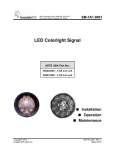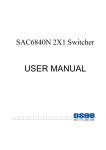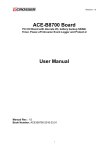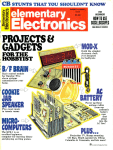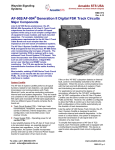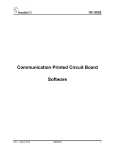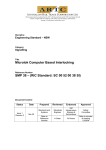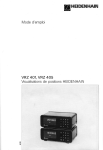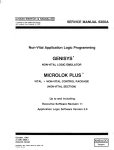Download SM-6800N - Ansaldo STS
Transcript
Union Switch & Signal Inc., an Ansaldo Signal company 1000 Technology Drive, Pittsburgh, PA 15219 ● 645 Russell Street, Batesburg, SC 29006 SM 6800N MicroLok® II LED Signal System with the US&S LED12 PCB US&S Part No. N4620440X Installation Operation Maintenance Copyright © 2007 Union Switch & Signal Inc. Original June 2007 Proprietary Notice This document and its contents are the property of Union Switch & Signal Inc. hereinafter US&S). This document has been furnished to you on the following conditions: no right or license under any patents or any other proprietary right in respect of this document or its content is given or waived in supplying this document. This document or its content are not to be used or treated in any manner inconsistent with the rights of US&S, or to its detriment, and are not to be copied, reproduced, disclosed to others, or disposed of except with the prior written consent of US&S. Important Notice US&S constantly strives to improve our products and keep our customers apprised of changes in technology. Following the recommendations contained in the attached service manual will provide our customers with optimum operational reliability. The data contained herein purports solely to describe the product, and does not create any warranties. Within the scope of the attached manual, it is impossible to take into account every eventuality that may arise with technical equipment in service. Please consult your local US&S sales representative in the event of any irregularities with our product. We expressly disclaim liability resulting from any improper handling or use of our equipment, even if these instructions contain no specific indication in this respect. We strongly recommend that only approved US&S spare parts be used as replacements. SM 6800N, Original, June 2007 i Revision History Revision History ii Rev. Date Nature of Revision Original June 2007 Initial Issue SM 6800N, Original, June 2007 Table of Contents 1 Introduction............................................................................................................................... 1-1 2 2.1 2.2 2.3 2.4 2.5 System Description .................................................................................................................. 2-1 LED Signals........................................................................................................................... 2-1 The LED12 PCB .................................................................................................................... 2-2 Driver Protection PCB ........................................................................................................... 2-3 Constant Current Regulator................................................................................................... 2-4 Detailed System Description ................................................................................................. 2-5 3 LED System Installation ........................................................................................................... 3-1 3.1 Mechanical Installation .......................................................................................................... 3-1 3.2 System Wiring ....................................................................................................................... 3-1 3.2.1 LED12 PCB Upper Connector and Address Selection .................................................. 3-1 3.2.2 Signal and Protection Board Wiring ............................................................................... 3-1 3.3 Example Wiring Diagrams ..................................................................................................... 3-4 3.3.1 Standard Configuration with Regulator Sharing............................................................. 3-4 3.3.2 Common Return Configuration With Failover-to-Red .................................................... 3-6 3.3.3 Standard Configuration .................................................................................................. 3-8 3.3.4 Multiple MicroLoks at a Single Location......................................................................... 3-8 4 Application Logic Programming................................................................................................ 4-1 4.1 Board Declaration.................................................................................................................. 4-1 4.2 Example Declaration ............................................................................................................. 4-1 4.3 PCB System Bits ................................................................................................................... 4-1 4.3.1 NV.PB ............................................................................................................................ 4-1 4.3.2 Retest.LEDs ................................................................................................................... 4-2 4.3.3 Example Usage of Board System Bits ........................................................................... 4-2 4.4 Sample Application Program .................................................................................................4-2 4.5 Application Programming Notes ............................................................................................ 4-6 4.5.1 Flashing.......................................................................................................................... 4-6 5 LED Signal System Troubleshooting........................................................................................ 5-1 5.1 Typical System Measurements ............................................................................................. 5-1 5.1.1 Constant Current Regulator ........................................................................................... 5-1 5.1.2 LED12 Board.................................................................................................................. 5-2 5.1.3 Driver Protection Board..................................................................................................5-2 5.1.4 LED Signal ..................................................................................................................... 5-2 5.1.5 Replacing LED Protection Board ................................................................................... 5-2 5.2 LED Fault Detection (Light-Out) ............................................................................................5-3 5.3 Troubleshooting Notes .......................................................................................................... 5-4 5.3.1 Field Testing Open Signal Detection.............................................................................. 5-4 5.3.2 Operation without the Constant Current Regulator Connected...................................... 5-5 5.3.3 Failure to Provide Field Side Power to LED12 Board .................................................... 5-5 5.3.4 Hints on Troubleshooting LED Signals .......................................................................... 5-5 6 Parts List .................................................................................................................................. 6-1 7 RAIL Team and Technical Support .......................................................................................... 7-1 SM 6800N, Original, June 2007 iii Table of Contents List of Figures Figure 1–1 - The Components of the US&S LED Signal System ..................................................... 1-1 Figure 2–1 - LED System ................................................................................................................. 2-1 Figure 2–2 - The LED Signal ............................................................................................................ 2-1 Figure 2–3 - The LED12 Card .......................................................................................................... 2-2 Figure 2–4 - Driver Protection PCB (N4620520X)............................................................................ 2-3 Figure 2–5 - Constant Current Regulator (N34801301) ................................................................... 2-4 Figure 2–6 - Typical Existing Signaling System Block Diagram ....................................................... 2-5 Figure 2–7 - US&S LED Signal System Block Diagram ................................................................... 2-5 Figure 3–1 - LED Signal Driver Pinout Drawing ............................................................................... 3-2 Figure 3–2 - Standard Configuration – Regulator Sharing ............................................................... 3-5 Figure 3–3 - Common Return Configuration with Failover-to-Red ................................................... 3-7 Figure 3–4 - Standard Configuration – Regulator Sharing (Double Break) ...................................... 3-9 Figure 5–1 - Pins on the Constant Current Regulator ...................................................................... 5-1 Figure 5–2 - LED Protection Board Orientation LED Signal ............................................................. 5-3 List of Tables Table 3-1 - Maximum Signal Distance from the Signal House ......................................................... 3-1 Table 5-1 - Valid Constant Current Regulator Readings .................................................................. 5-1 Table 5-2 - Valid LED12 Vital Output Readings ............................................................................... 5-2 Table 5-3 - Fault Clearing Logic ....................................................................................................... 5-4 Table 6-1 - Part Numbers for the US&S LED Signal System Components...................................... 6-1 iv SM 6800N, Original, June 2007 Introduction 1 Introduction The Union Switch and Signal (US&S) LED Signal System consists of the LED signals (in four distinct colors) (PN N4620440X) complete with the LED Protection Board (PN N46205001), a Constant Current Regulator (PN N34801301), an LED12 Signal Driver Printed Circuit Board (PCB) (PN N17066101), and a Driver Protection PCB (PN N4620520X). The LED12 Signal Driver PCB controls the US&S LED signals. CAUTION The LED12 Signal Driver PCB is designed to vitally drive the US&S LED signals and only those signals. It must not be used to drive incandescent signals or other non-US&S LED signals. Each LED signal contains several high-intensity LEDs which operate on a constant current provided by the constant current regulator. The LED12 PCB provides vital control of the signals, turning them on and off as needed, and monitors their condition. The Driver Protection PCB is in series with the signal and provides surge protection for the signal. The components of the system are ordered separately and installed as a system based on the specific application of the signals. All of the components of the system are shown in Figure 1–1. LED Signal Complete with LED Protection PCB The LED 12 Signal Driver Board The Driver Protection Board Constant Current Regulator Figure 1–1 - The Components of the US&S LED Signal System SM 6800N, Original, June 2007 1-1 Introduction 1-2 SM 6800N, Original, June 2007 System Description 2 System Description This section contains a brief description of the LED System components and their function in relation to the overall system. A block diagram of the LED System is shown in Figure 2–1. G96 BUS to CPU VCOR Contact Constant Current Regulator (N34801301) Output Battery LED Driver PCB (N17066101) WAYSIDE FIELD WIRING LED Driver PCB Protection Board (N4620520x) SIGNAL HEAD LED Signal Protection Board (N46205001) LED Signal (N4620440x) Figure 2–1 - LED System 2.1 LED Signals The LED signals (Figure 2–2) are available in red, amber (yellow), cyan (green), and lunar (white) in 6-3/8” diameter (PN N4620480X). These signals include high intensity LEDs, in series, which are powered by a constant current source. Because the signals are designed to operate with an external constant current source; no DC/DC converters or other active electronics are included. The signal system only includes LEDs and other passive components for diagnostics and surge protection. When combined with the vital output LED12 Signal Driver PCB, the system can provide true light-out detection. LED PROTECTION BOARD FRONT GROUND STUD BACK Figure 2–2 - The LED Signal SM 6800N, Original, June 2007 2-1 LED System Description 2.2 The LED12 PCB The LED12 Signal Driver PCB (N17066101) (Figure 2–3) provides 12 vital outputs to control the LED signals. These outputs are controlled by “high side” software-controlled switches, which connect and disconnect the output of the constant current regulators for the LED signals. The LED12 PCB performs diagnostic and light-out detection functions without the use of external “check pulses.” In addition it provides a continuous continuity check of the LEDs. The LED12 PCB has a non-vital pushbutton on the front panel to set the state of the board’s system bit (refer to Section 4.3.1). The LED12 PCB is designed to be installed in the standard MicroLok II cardfile. The LED12 PCB can light all of the LED signals at once if necessary provided there is a current regulator for each of the LED signals (Section 2.4). CAUTION The LED12 Signal Driver PCB is designed to vitally drive the US&S LED signals and only those signals. It must not be used to drive incandescent signals or other non-US&S LED signals. Figure 2–3 - The LED12 Card 2-2 SM 6800N, Original, June 2007 System Description 2.3 Driver Protection PCB The Driver Protection PCB (N4620520X) (Figure 2–4) is an entrance panel mounted board. It is used in combination with US&S lightning arrestors to provide a high level of surge protection for the Signal Driver board. The Driver Protection PCB (N46205201), which is mounted in the house, is designed to terminate house wiring on the left hand side of the board and field wiring on the right hand side of the board. An optional version of the Driver Protection PCB (N46205202) allows terminating the house wiring on the right hand side of the board and field wiring on the left hand side of the board. Both versions of the board use the same components and allow the components to be viewed for inspection when mounted in the house. DRIVER BOARD PROTECTION PCB (N46205201) HOUSE WIRING ON LEFT SIDE OF BOARD DRIVER BOARD PROTECTION PCB (N4620502) HOUSE WIRING ON RIGHT SIDE OF BOARD Figure 2–4 - Driver Protection PCB (N4620520X) SM 6800N, Original, June 2007 2-3 LED System Description 2.4 Constant Current Regulator CAUTION The constant current regulator is designed to be installed on a standard DIN rail. When installed with other regulators there should be at least a 1/2” separation between the regulators. The Constant Current Regulator (PN N34801301) (Figure 2–5) provides a constant 350mA regulated current output for driving the LED signals. The output of the regulator includes both open and short circuit protection. Note Only US&S Constant Current Regulators are to be used with the US&S LEDs. A regulator is required for each “ON” LED signal in a system; however, a regulator can be shared between signals that will never be on at the same time. The power consumption of the constant current regulator is: With the Regulator Powered and the LED signal ON - 16.5W With the Regulator Powered and the LED signal OFF - 1.6W Figure 2–5 - Constant Current Regulator (N34801301) 2-4 SM 6800N, Original, June 2007 System Description 2.5 Detailed System Description The US&S LED Signal System is a unique concept in railroad LED signaling. Some LED equipment has been designed to perform like incandescent bulbs; so they can be powered by existing incandescent lamp drivers. The US&S LED Signal operates from an external constant current source. This design allows for accurate monitoring of the operational state of the LED devices in the signal. Figure 2–6 illustrates a typical existing signaling system, where a software-controlled switch is used to apply and remove a voltage source (battery) from the signal load. Figure 2–7 illustrates the US&S LED Signal System. This system differs from the typical existing system in that the signal load is powered by an external regulated current source (rather than a voltage source) which is applied and removed from the signal load via a software-controlled switch. INCANDESCENT OR LED SIGNAL WITH INTERNAL DC TO DC CONVERTER, POWER SUPPLY, AND REGULATOR + _ SOFTWARE CONTROLLED SWITCH BATTERY (9.8 - 16.2V) Figure 2–6 - Typical Existing Signaling System Block Diagram US&S CONSTANT CURRENT REGULATOR 350mA SOFTWARE CONTROLLED SWITCH US&S LED SIGNAL + _ BATTERY (9.8 - 16.2V) Figure 2–7 - US&S LED Signal System Block Diagram SM 6800N, Original, June 2007 2-5 LED System Description 2-6 SM 6800N, Original, June 2007 LED System Installation 3 LED System Installation 3.1 Mechanical Installation ® The LED12 board is installed as part of the MicroLok II system, the Constant Current Regulator is DIN-rail mounted in the house, and the Driver Board Protection PCB is mounted on the AAR terminals at the entrance rack. 3.2 System Wiring 3.2.1 LED12 PCB Upper Connector and Address Selection The pinouts and addresses for the LED board are presented in Figure 3–1. Note Even though the LED12 PCB will light up to 12 LED signals at once, the figures in this manual show, in most cases, only three LED signals for illustration purposes only and are not meant to imply that the LED12 PCB should be limited to lighting only three LED signals at once. Nor should it be inferred that the LED signals be all located in the same signal head. 3.2.2 Signal and Protection Board Wiring Table 3-1 summarizes the maximum distance a signal can be located from the signal house based on the wire gauge selected for the application. As noted in the table, the distances already include the series resistance of all the lightning/surge protection circuitry. However, the series resistance of additional components such as house wiring, relay contacts, and terminal connections will reduce the maximum distance for a signal (they will need to be included in the 3-ohm limit for each leg). Table 3-1 - Maximum Signal Distance from the Signal House Wire Gauge (AWG) Note 1 Ohms per 1000 ft Maximum signal distance (wire length for each leg) 6 0.3951 7500 ft 8 0.6282 4700 ft 9 0.7921 3700 ft 10 0.9989 3000 ft 12 1.588 1800 ft 14 2.525 1100 ft Distances are based on maximum line resistance of 3 ohms per leg (6 ohms total). Note 2 Distances include series resistance of all lightning/surge protection circuits. Note 3 Additional series resistance of house wiring, relay contacts, terminal connections, etc. will reduce the maximum distances allowed. SM 6800N, Original, June 2007 3-1 LED System Installation Top Connector Address Select Jumpers PCB 48-pin Top Connector Pin-Outs SEL+ SW1 E32 White E30 Brown C30 Red A30 Orange E28 Yellow C28 Green A28 Blue E26 Black SW2 SW3 SW4 SW5 SW6 GND B12 Constant Current Regulator N34800101 VCOR Relay 3 BATT+ 1 BATT - 3 BATT+ 1 BATT - N12 B12 VCOR Relay OUT OUT * Either Out 2 or 4 can be used for input to PCB To Board Addressing Circuits FIELD WIRING SIGNAL HOUSE Software Controlled Switches 4* LED Signal E12 IN #1 LED #1 E2 C16 IN #2 LED #2 C2 E14 IN #3 LED #3 E4 C22 IN #4 LED #4 C4 LED Protection PCB LED Driver Protection PCB LED PCB LED 2* 4 SIGNAL HEAD RED USGA RED EARTH LED Protection PCB LED PCB 2 E16 IN #5 LED#5 E6 C24 IN #6 LED #6 C6 C26 IN #7 LED #7 C10 LED AMBER (YELLOW) USGA RED EARTH LED Protection PCB LED PCB LED CYAN (GREEN) USGA RED EARTH N12 E24 IN #8 LED #8 E10 A22 IN #9 LED #9 A16 A24 IN #10 LED #10 A18 A12 IN #11 LED #11 A20 EARTH LED Signal LED Protection PCB LED Driver Protection PCB LED PCB LED USGA RED RED USGA RED A14 IN #12 US&S LED Signal LED #12 E22 EARTH LED Protection PCB EARTH USGA BLUE LED PCB LED E18 AMBER (YELLOW) USGA RED E20 US&S LED Signal EARTH LED Protection PCB C18 LED PCB LED CYAN (GREEN) N12 USGA RED EARTH C20 E8 C8 C12 A2 A4 A6 A8 A10 C12 C14 USGA RED N12 EARTH EARTH LED12 Driver Vital Output PCB Figure 3–1 - LED Signal Driver Pinout Drawing 3-2 SM 6800N, Original, June 2007 LED System Installation The following is a list of wiring specific requirements/notes for the US&S LED Signal System: • For all applications, the use of the lightning/surge protection components of the LED signal system is required. • US&S recommends the use of twisted pair wiring (two to three turns per foot) to minimize possible noise. This should be done wherever possible on all I/O wiring. • US&S recommends the physical separation of clean and noise generating wiring. Ideally, all outputs are gathered in one bundle, inputs are gathered in another bundle, and power wiring is gathered in a third bundle. Each of these bundles is physically separated from each other (6” preferred) and all bundles are physically separated from other house wiring. It is particularly important to maintain this physical separation from high-current, noise generating wiring. • All field wiring should be configured to minimize cross talk between wires. Cables and wires should be kept as short as possible to minimize induced line noise. Case/house wiring layouts should also be arranged to minimize noise. Battery leads should be as short as possible and must be isolated as much as possible from noisy wiring. • The US&S Common Mode Filter (N4515521001) is recommended for use on the battery lines to the MicroLok II and all battery-powered LED signal system components (including battery broken-by-relay contacts). This filter needs to be located as close as possible to the equipment to maximize its effectiveness. Note that on MicroLok II systems that include LAMP16 PCBs in addition to LED12 PCBs, power to the LAMP16 PCB and incandescent signals must NOT be filtered. Using the filter in this instance can cause check-pulse problems. • Additional loads, such as local indicators, cannot be connected across the signal leads of the LED signal. • Multiple signals cannot be wired in series or parallel (i.e., color position lights must be separately wired to individual constant current sources). • The outputs of multiple constant current sources should not be connected in parallel or series. • Fuses are not needed/recommended on the signal outputs; the US&S constant current regulator output includes short-circuit protection, and no damage will occur to the system if an output is inadvertently shorted to ground. Fuses can be installed on the system battery connections to the system as required. These fuses can be installed in the circuit between VCOR-1 and terminal B12. • Slide-wire resistors are not required for use with the LED signals and should never be installed. Also, the LED signals cannot be dimmed by switching in a series resistance, as can typically be done with an incandescent signal. • The LED signal has five terminals which are clearly marked (three require a field connection; two have no external connection). Ensure that the connections are made to the proper terminals. • The LED signal field terminals have a polarity that must be observed, where incandescent signals typically do not. A signal hooked up with reversed polarity will not operate and could eventually damage the signal. SM 6800N, Original, June 2007 3-3 LED System Installation 3.3 Example Wiring Diagrams 3.3.1 Standard Configuration with Regulator Sharing Figure 3–2 illustrates the standard configuration for the LED signal system components with regulator sharing (three signals shown). The constant current regulator can only power one LED signal at a time. If multiple LED signals will never be on at the same time, these LED signals can share the same constant current regulator. Because the constant current regulator is only in use when a signal is the ON state, a single constant current regulator can be shared between multiple signals provided that only one signal is ON at any given time. VCOR contacts are used on the B12 power supplied to the LED12 PCB and the constant current regulator(s), so that under a system reset condition all signals will be dark. The maximum allowable length for the field wiring can be found in Table 3-1. 3-4 SM 6800N, Original, June 2007 B12 SM 6800N, Original, June 2007 N12 VCOR-1 N12 B12 1 3 1 3 1 3 OUT OUT EARTH USGA RED USGA BLUE BATT- BATT+ EARTH USGA RED OUT Constant Current Regulator BATT- BATT+ Constant Current Regulator BATT- BATT+ Constant Current Regulator 2 4 2 4 2 4 VCOR-1 LED12 PCB BATT + C4 C22 A16 A22 E8 C8 C12 C14 A2 A4 A6 A8 A10 BATT- E22 A14 E18 E20 C18 C20 A20 A12 A18 E10 E24 A24 C10 C6 C26 C24 E6 E4 E14 E16 C2 E2 C16 E12 (ADDRSEL I /O not shown ) N12 USGA RED Driver Protection PCB USGA RED Driver Protection PCB USGA RED Driver Protection PCB EARTH EARTH EARTH SIGNAL HOUSE FIELD WIRING LED LED PCB LED SIGNAL LED Protection PCB LED LED PCB LED SIGNAL LED Protection PCB LED LED PCB LED SIGNAL LED Protection PCB EARTH SIGNAL HEAD LED System Installation Figure 3–2 - Standard Configuration – Regulator Sharing 3-5 LED System Installation 3.3.2 Common Return Configuration With Failover-to-Red Figure 3–3 illustrates the common return configuration for the LED signaling system components (three signals shown) when using a shared regulator and failover-to-red. This configuration is supported with the following limitations: • Only one signal can be on at a given time since the regulator is being shared. • The resistance of the common return leg must be kept as low as possible within the 3-ohm limit as described in Table 3-1. The heaviest gauge wire possible should be used for this return. Three VCOR contacts are used to implement failover-to-red for a signal head: • VCOR-1 – The back contact connects the constant current regulator output directly to the RED signal when the system is in reset, causing it to light. During normal operation, the front contact will connect the constant current regulator output to the driver board, so that all signals can be powered under application control. • VCOR-2 – The back contact connects the RED signal directly to the constant current regulators output when the system is in reset, causing it to light. During normal operation, the front contact will connect the RED aspect to the driver board, and the state of the RED aspect will be under application control. • VCOR-3 – This contact removes B12 from the LED12 board. Note how the power to the regulators is not broken by a relay contact (the contacts are on the output of the regulator). The maximum allowable length for the field wiring can be found in Table 3-1. 3-6 SM 6800N, Original, June 2007 B12 SM 6800N, Original, June 2007 N12 VCOR-1 N12 B12 1 3 EARTH USGA RED USGA BLUE BATT- BATT+ EARTH USGA RED OUT Constant Current Regulator 2 4 VCOR-1 LED12 PCB BATT + E8 C8 C12 C14 A2 A4 A6 A8 A10 BATT- E22 A14 N12 A20 A12 E18 E20 C18 C20 A18 C10 C26 A24 C6 C24 A16 E6 E16 A22 C4 C22 E10 E4 E14 E24 C2 E2 C16 E12 (ADDRSEL I /O not shown) VCOR -2 USGA RED Driver Protection PCB USGA RED Driver Protection PCB USGA RED Driver Protection PCB EARTH EARTH EARTH SIGNAL HOUSE FIELD WIRING EARTH SIGNAL HEAD LED Protection PCB LED Protection PCB CYAN (GREEN) LED LED PCB LED AMBER (YELLOW) LED PCB RED LED LED PCB LED SIGNAL LED Protection PCB LED System Installation Figure 3–3 - Common Return Configuration with Failover-to-Red 3-7 LED System Installation 3.3.3 Standard Configuration – Regulator Sharing (Double Break) As a variation on the standard configuration shown in Figure 3–2, a relay contact can also be added to the return of the signals, as shown in Figure 3–4 (VCOR-2) to provide a double-break (both power and ground) to the signals under a reset condition. The maximum allowable length for the field wiring can be found in Table 3-1. 3.3.4 Multiple MicroLoks at a Single Location In locations where there are two or more MicroLok II cardfiles that are each driving US&S LED signals, there are specific application requirements to ensure that when one or more MicroLok II are under reset conditions the aspects return to a known safe state: 3-8 • All relay contacts corresponding to a single MicroLok II cardfile LED signal system shall be energized by the CPS in that system. Do not use the CPS from another cardfile to energize relays, or share a single CPS between all of the cardfiles. This is necessary as all the cardfiles in the location will likely not reset at the same time. • Do not share the constant current regulators between signals driven by separate cardfiles. • Make use of the “double break” scheme as shown in Figure 3–4. This will prevent signals from lighting due to output shorts between the I/O of the separate cardfiles. SM 6800N, Original, June 2007 B12 SM 6800N, Original, June 2007 N12 VCOR-1 N12 B12 1 3 EARTH USGA RED USGA BLUE BATT- BATT+ EARTH USGA RED OUT Constant Current Regulator 2 4 VCOR-1 LED12 PCB BATT+ E10 A16 A18 A20 E22 E24 A22 A24 A12 A14 E8 C8 C12 C14 A2 A4 A6 A8 A10 BATT - C10 C26 E18 E20 C18 C20 C6 C24 C4 C22 E6 E4 E14 E16 C2 E2 C16 E12 (ADDRSEL I /O not shown ) N12 USGA RED Driver Protection PCB USGA RED Driver Protection PCB USGA RED Driver Protection PCB EARTH EARTH EARTH SIGNAL HOUSE FIELD WIRING EARTH LED Protection PCB LED Protection PCB LED CYAN (GREEN) LED PCB AMBER (YELLOW) LED LED PCB RED LED LED PCB LED SIGNAL LED Protection PCB SIGNAL HEAD LED System Installation Figure 3–4 - Standard Configuration – Regulator Sharing (Double Break) 3-9 LED System Installation 3-10 SM 6800N, Original, June 2007 Application Logic Programming 4 Application Logic Programming 4.1 Board Declaration This section contains the information on how to declare a board in a MicroLok II Application Program. 4.2 Example Declaration BOARD: Board.Name ADJUSTABLE ENABLE: 1 TYPE: LED12 OUTPUT: SIGNAL.OUTPUT.1, SIGNAL.OUTPUT.2, SIGNAL.OUTPUT.3, SIGNAL.OUTPUT.4, SIGNAL.OUTPUT.5, SIGNAL.OUTPUT.6, SIGNAL.OUTPUT.7, SIGNAL.OUTPUT.8, SIGNAL.OUTPUT.9, SIGNAL.OUTPUT.10, SIGNAL.OUTPUT.11, SIGNAL.OUTPUT.12; SIGNAL.GOOD: SIGNAL.GOOD.1, SIGNAL.GOOD.2, SIGNAL.GOOD.3, SIGNAL.GOOD.4, SIGNAL.GOOD.5, SIGNAL.GOOD.6, SIGNAL.GOOD.7, SIGNAL.GOOD.8, SIGNAL.GOOD.9, SIGNAL.GOOD.10, SIGNAL.GOOD.11, SIGNAL.GOOD.12; As for other vital I/O boards, unused outputs must be declared as SPARE if a higher numbered output is used. Unused outputs above the highest number used output do not have to be declared. 4.3 PCB System Bits This section describes two bits unique to the LED12 PCB – the NV.PB bit and the Retest.LEDs bit. 4.3.1 NV.PB The LED12 PCB has a non-vital pushbutton on the front panel. Pressing this button sets the state of the board’s system bit, NV.PB. The MicroLok II must detect the button to have been released before it will respond to a second set. This non-vital input can be used in the application to trigger logic. An example is presented in Section 4.4. WARNING Application logic should be written to always examine the SIGNAL.GOOD system bit and to turn OFF a signal that has been detected by the MicroLok II diagnostics to be faulty. Failure to do so may result in a signal that could appear as partially illuminated or intermittent which could cause problems. This is similar to the way the LAMP.OUT system bit must be used for lamps driven by the LAMP16 board. Refer to US&S Service Manual SM-6800D, Appendix B. Note that the polarity of the SIGNAL.GOOD system bit is SET when the MicroLok II diagnostics determine the signal to be working properly, and CLEAR when they determine the signal to be faulty. This is the opposite of the polarity for the LAMP.OUT system bit used for LAMP16 signals. SM 6800N, Original, June 2007 4-1 Application Logic Programming 4.3.2 Retest.LEDs Setting this application bit (1) will clear the fault status and set the .SIGNAL.GOOD bits for all signals connected to the LED12 board. Retesting of the signals will commence immediately and in one second the fault status of all signals, and their .SIGNAL.GOOD bits, will be updated. The Retest.LEDs system bit has a slow pick of three seconds, is edge triggered, and has a slow drop of 10 seconds. The application bit must be set (1) for three seconds before the application will process the system bit. The Retest.LEDs must be cleared (0) before the application will recognize another set (1). After the Retest.LEDs system bit is set (1), no transitions of the bit will be processed for 10 seconds. This prevents logic from repeatedly clearing the fault status. 4.3.3 Example Usage of Board System Bits ASSIGN BoardName.LED12.NV.PB to BoardName.LED12.Retest.LEDs; 4.4 Sample Application Program /* Example program is an intermediate with a DC track and Vital Peer link on one side and a Microtrax Coded Track Circuit on the other side, using an LED 12 and a Lamp 16 lamp driver in a Microlok II Card File. Both the Lamp 16 and LED 12 are shown to illustrate the differences in using this boards. */ INTERFACE LOCAL /* Track board, maybe disabled for trouble shooting purposes. to perform any useful function. */ This board is required for the program BOARD: MTRX ADJUSTABLE ENABLE: 1 TYPE: TRX.TRACK TRACKA: EN_ADJ_R TRACK.NAME: EAST_TRACK OUTPUT: E_D_OUT, E_E_OUT, E_F_OUT, SPARE, E_H_OUT, E_I_OUT, E_J_OUT, E_K_OUT, SPARE, SPARE, SPARE, SPARE, SPARE, SPARE, E_R_OUT, E_S_OUT, E_T_OUT, E_U_OUT, E_V_OUT, E_W_OUT; INPUT: E_D_IN, E_E_IN, E_F_IN, E_G_IN, E_H_IN, E_I_IN, E_J_IN, E_K_IN, E_L_IN, E_M_IN, E_N_IN, E_O_IN, E_P_IN, E_Q_IN, E_R_IN, E_S_IN, E_T_IN, E_U_IN, E_V_IN, E_W_IN; ADJUSTABLE LENGTH: 9; ADJUSTABLE ENABLE: 1; TRACKB: EN_ADJ_L TRACK.NAME: WEST_TRACK OUTPUT: SPARE; INPUT: SPARE; ADJUSTABLE LENGTH: 9; FIXED ENABLE: 0; 4-2 SM 6800N, Original, June 2007 Application Logic Programming BOARD: WEST_SIG ADJUSTABLE ENABLE: 1 TYPE: LED12 /* In this example the LED 12 is used for the West Bound signal aspects. Not all aspects need to be defined, only those that are used. If you wish to skip an output location, label it SPARE. In this example outputs 1-3 and 5-7 are used. Output 4 is not used and labeled as a SPARE. All 12 outputs can be listed, but are not required if they are not used. */ OUTPUT: WAGE, WAYE, WARE, SPARE, WBGE, WBYE, WBRE; /* The LED 12 uses the Signal.Good executive bit. This bit is set when the lamp is believed to be in a useable condition based on the tests performed by the Microlok II executive. The Signal.Good bits are listed in the same order as the aspect bits. WAGLOR is the Signal.Good bit for WAGE, because these bits appear in the first position in the board definition. */ SIGNAL.GOOD: WAGLOR, WAYLOR, WARLOR, SPARE, WBGLOR, WBYLOR, WBRLOR; BOARD: EAST_SIG ADJUSTABLE ENABLE: 1 TYPE: LAMP16 ADJUSTABLE 18 WATT MODE 1 OUTPUT: EAGE, EAYE, EARE, SPARE, EBGE, EBYE, EBRE; /* Refer to SM 6800D for detailed information on the Lamp 16 definition. Notice that this lamp board uses Lamp.Out instead of Signal.Good. The Lamp.Out bit is set when the lamp is believed to be bad based on the tests performed by the Microlok II executive. So it status is inverted as compared to Signal.Good. */ LAMP.OUT: EAG_LO, EAY_LO, EAR_LO, SPARE, EBG_LO, EBY_LO, EBR_LO; BOARD: VIO ADJUSTABLE ENABLE: 1 TYPE: IN8.OUT8 OUTPUT: ELR_OUT, WLR_OUT; INPUT: WTR_IN; COMM LINK: PEERLINK ADJUSTABLE ENABLE: 1 PROTOCOL: MII.PEER ADJUSTABLE PORT: 4; ADJUSTABLE POINT.POINT: 1; ADJUSTABLE BAUD: 19200; ADJUSTABLE STOPBITS: 1; ADJUSTABLE PARITY: NONE; SM 6800N, Original, June 2007 4-3 Application Logic Programming ADJUSTABLE KEY.ON.DELAY: 0; ADJUSTABLE KEY.OFF.DELAY: 0; ADJUSTABLE GRANT.DELAY: 250:MSEC; ADJUSTABLE MII.ADDRESS: 10 ADJUSTABLE ENABLE: 1 STATION.NAME: MLK.CNTRL.POINT; ADJUSTABLE PEER.ADDRESS: 20; ADJUSTABLE TIME.STAMP: 1; ADJUSTABLE ACK.TIMEOUT: 2400:MSEC; ADJUSTABLE HEARTBEAT.INTERVAL: 2400:MSEC; ADJUSTABLE INDICATION.UPDATE.CYCLE: 2; ADJUSTABLE STALE.DATA.TIMEOUT: 6000:MSEC; ADJUSTABLE CLOCK.MASTER: 0; INPUT: WHR_IN, WDR_IN, WFYR_IN, WTR_SIN, WBKR_IN; OUTPUT: WHR_OUT, WDR_OUT, WFYR_OUT, WYLR_OUT, WYYR_OUT, WTR_OUT, WBKR_OUT, WMK_OUT; ADJUSTABLE MII.NV.ADDRESS: 11 ADJUSTABLE ENABLE: 1 STATION.NAME: CRS_LIGHT; ADJUSTABLE PEER.ADDRESS: 12; ADJUSTABLE TIME.STAMP: 1; ADJUSTABLE ACK.TIMEOUT: 400:MSEC; ADJUSTABLE HEARTBEAT.INTERVAL: 400:MSEC; ADJUSTABLE INDICATION.UPDATE.CYCLE: 2; ADJUSTABLE STALE.DATA.TIMEOUT: 1:SEC; ADJUSTABLE CLOCK.MASTER: 0; NV.OUTPUT: WAE_OUT, EAE_OUT; /* Master West Approach Energy */ /* Master East Approach Engery */ NV.INPUT: WAE_IN, EAE_IN; /* Master West Approach Energy IN */ /* Master East Approach Enerpy IN */ BOOLEAN BITS >-----------------------------------------------------------------------------------------------------------------------------------------------> CONFIGURATION SYSTEM ADJUSTABLE DEBUG_PORT_ADDRESS:1; ADJUSTABLE DEBUG_PORT_BAUDRATE:9600; ADJUSTABLE LOGIC_TIMEOUT:2000:MSEC; ADJUSTABLE DELAY_RESET:0:MSEC; APPLICATION.VERSION:1; LOGIC BEGIN /* This statement prevents this application from running in a card file it has not been configured for. */ ASSIGN CONFIGURE.ERROR TO KILL_SP; /* The Microlok II CPU can sound two audible tones. Below is an example of how this can be used to make the application software more user friendly. */ NV.ASSIGN CONFIGURE.ERROR TO ALARM.1; 4-4 SM 6800N, Original, June 2007 Application Logic Programming NV.ASSIGN MTRX.WEST_TRACK.SLEEPIN + MTRX.WEST_TRACK.TDIN TO TD_W_BEEP.TER; NV.ASSIGN MTRX.EAST_TRACK.SLEEPIN + MTRX.EAST_TRACK.TDIN TO TD_E_BEEP.TER; NV.ASSIGN ~TD_W_BEEP.TER * (MTRX.WEST_TRACK.SLEEPIN + MTRX.WEST_TRACK.TDIN) +~TD_E_BEEP.TER * (MTRX.EAST_TRACK.SLEEPIN + MTRX.EAST_TRACK.TDIN) TO ALARM.2; /* Delay kill for 3 seconds to prevent surge on power supply */ ASSIGN KILL_SP TO KILL; /* If unit is running in limited mode, ‘Auto Reset’ after 10 minutes */ ASSIGN ERROR.RESTRICTED TO CPS_SP; ASSIGN CPS_SP TO CPS.RESET; /* CPS.ENABLE must be set for the VCOR to pick. user to change the track length. */ EN_ADJ_L and EN_ADJ_R must be set for the ASSIGN ONE TO CPS.ENABLE, EN_ADJ_L, EN_ADJ_R; >-----------------------------------------------------------------------------------------------------------------------------------------------------------------------------------> /* Because the Lamp 16 defines a Lamp.Out bit instead of a Signal.Good, Light On Relays are built in application logic. As shown the EARLOR functions the same as the WARLOR defined in the LED 12 definition. */ ASSIGN ~EAR_LO * EAST_SIG.ENABLED * CPS.STATUS TO EARLOR; ASSIGN ~EAY_LO * EAST_SIG.ENABLED * CPS.STATUS TO EAYLOR; ASSIGN ~EAG_LO * EAST_SIG.ENABLED * CPS.STATUS TO EAGLOR; ASSIGN ~EBR_LO * EAST_SIG.ENABLED * CPS.STATUS TO EBRLOR; ASSIGN ~EBY_LO * EAST_SIG.ENABLED * CPS.STATUS TO EBYLOR; ASSIGN ~EBG_LO * EAST_SIG.ENABLED * CPS.STATUS TO EBGLOR; >---------------------------------------------------------------------------------------------------------------------------------------------------------------------------------------------------> /* Green lamp good, unit can display green */ ASSIGN EDR * EAGLOR TO EDRP; /* Signal can display FY */ ASSIGN (EFYR + EDR * ~EAGLOR) * EAYLOR TO EFYRP; >---------------------------------------------------------------------------------------------------------------------------------------------------------------------------------------------------> /* Signal can display green */ ASSIGN WDR * WAGLOR TO WDRP; /* Signal can display FY */ ASSIGN (WFYR + WDR * ~WAGLOR) * WAYLOR TO WFYRP; >---------------------------------------------------------------------------------------------------------------------------------------------------------------------------------------------------> /* WEST_SIG.NV.PB is an executive bit that is true when the user presses the Lamp Reset button on the front of the LED 12. The executive will ensure that this bit is not set if the button is stuck, the executive also filters the button so that the bit will not set if the button is momentarily pressed. WEST_SIG.Reset.LEDs is the executive bit that, when set, will clear all of the LO latches for the board. Retest.LEDs could be assigned in different ways, for example an office control could be used. SM 6800N, Original, June 2007 4-5 Application Logic Programming */ ASSIGN WEST_SIG.NV.PB TO WEST_SIG.Retest.LEDs; NV.ASSIGN WEST_SIG.Retest.LEDs TO LED.8; END LOGIC END PROGRAM 4.5 Application Programming Notes 4.5.1 Flashing To overcome the long turn-on time of an incandescent lamp, application programs frequently flashed the signal with a 60/40 duty cycle (60% of the time on, 40% off) resulting in the signal appearing to be 50% on and 50% off. Because the LED signals turn on and off almost instantaneously, a 50/50 duty cycle will provide the 50/50 visible flashing. 4-6 SM 6800N, Original, June 2007 LED Signal System Troubleshooting 5 LED Signal System Troubleshooting 5.1 Typical System Measurements This section provides a list of voltage and/or current measurement for a good system and for a faulty system. Measurements are taken with a meter using the MicroLok II Development System. 5.1.1 Constant Current Regulator Table 5-1 summarizes the expected measurements that can be observed from a functional constant current regulator operating off of a 9.8 to 16.2-volt source. Any readings outside the stated ranges indicate a possible faulty regulator. Table 5-1 - Valid Constant Current Regulator Readings Condition Expected Reading Voltage at output with no load connected (pin 4 referenced to pin1)* V = ~52V V = 0.35 * R +/-10%, where Voltage at output with resistive load connected (pin 4 referenced to pin1)* R <= 140ohms Voltage at output with a known good LED Signal connected - signal ON condition (pin 4 referenced to pin1)* 29V <= V <= 50V Current output with valid load - signal ON condition (pin 4)* I = 350mA ±10% * See Figure 5–1. N12 1 2 3 4 B12 LED OUTPUT CONSTANT CURRENT REGULATOR MODULE Figure 5–1 - Pins on the Constant Current Regulator SM 6800N, Original, June 2007 5-1 LED Signal System Troubleshooting 5.1.2 LED12 Board Table 5-2 summarizes the expected measurements that can be observed on the LED12 Vital Output Board output that is functioning properly with a good LED signal load. These measurements are taken with a meter at the signal output on the MicroLok II CPU front panel, or with the MicroLok II Maintenance Tool. Any readings outside of the stated ranges indicate a possible faulty system module. Table 5-2 - Valid LED12 Vital Output Readings Condition Expected Reading Output ON 29V <= V <= 48V I = 350mA ±10% Output OFF V < 0V (V should be negative) -150mA <= I < 0A 5.1.3 Driver Protection Board The expected voltage readings taken across the driver protection board field terminals will be the same or slightly less (due to resistance in the wiring) than the readings taken at the LED12 Vital Output Board outputs, shown in Table 5-2. Any readings outside of the stated ranges indicate a possible faulty driver protection board. 5.1.4 LED Signal The expected voltage readings taken across the LED Signal field wiring terminals will be the same or slightly less (due to resistance in the wiring) than the readings taken at the LED12 Vital Output Board outputs, shown in Table 5-2. Any readings outside of the stated ranges indicate a possible faulty LED signal. 5.1.5 Replacing LED Protection Board Inspect the components for signs of stress or damage. If present, replace the board with a spare and return the faulty board to US&S for repair. Figure 5–2 illustrates the proper orientation of the protection board on the back of the LED signal. 5-2 SM 6800N, Original, June 2007 LED Signal System Troubleshooting Figure 5–2 - LED Protection Board Orientation LED Signal 5.2 LED Fault Detection (Light-Out) The LED signal system follows the AREMA Guidelines for LED signals. The system repeatedly monitors the status signals connected to the LED12 board. On-state signals are monitored for open and short circuits between each signal’s leads. Off-state signals are monitored for continuity of the leads to the signal and short circuits between each signal’s leads. Faulty on- or off-state signals are detected in one second. Flashing signals can take up to two seconds to detect since the system is separately monitoring the on- and off-states. Once a signal has been determined to be faulty the MicroLok II system will log a warning and clear the faulty signal’s .SIGNAL.GOOD application bit (0). The LED12 front panel LED corresponding to the faulty signal will begin flashing. This flashing pattern is several quick on pulses followed by a longer off period. This distinguishes a faulty signal from a normally flashing signal. When any of the 12 LED12 outputs detects a faulty signal the red LED at the bottom of the front panel will also turn on. This LED quickly draws the maintainer’s attention to boards with faulty signals. Note Note that the SIGNAL.GOOD bit is set (1 state) when its attached signal is detected as good. A LAMP16 board’s LIGHT.OUT bit is set (1 state) when its attached signal is detected to be faulty. Replacing a faulty signal will be automatically detected and the faulty condition cleared in one second except in the condition of a faulty On signal. The fault clearing logic used on the LED12 board is shown on Table 5-3. SM 6800N, Original, June 2007 5-3 LED Signal System Troubleshooting Table 5-3 - Fault Clearing Logic * Output state when signal fault was detected. Current output state. After repairing the signal, the fault will be cleared by: ON ON Waiting five seconds or setting and clearing the .Retest.LED board application bit ON OFF Setting and clearing the .Retest.LED board application bit* OFF ON Waiting five seconds or setting and clearing the .Retest.LED board application bit OFF OFF Waiting five seconds or setting and clearing the .Retest.LED board application bit By requiring the logic bit to be set, we are preventing a signal that has; failed in the ON state and tests good in the OFF state, from being upgraded by the application logic. This may done by assigning .NV.PB (the LED12 board’s application bit associated with the NON-VITAL front panel pushbutton) to the .RetestLED board. Following AREMA guidelines a signal that is detected as faulty in the On-state will continue to be considered faulty in the Off-state. This prevents an application from inadvertently flashing a signal when it downgrades a faulty on signal. To clear the fault condition for a signal detected as faulty while in the on-state, the repaired signal either has to be turned on or the application logic must set and then clear the .Retest.LEDs board application bit. This is typically done by mapping the non-vital pushbutton on the front of the LED12 board to the retest bit. Adding the following line to the LOGIC section of an application program will do this mapping. ASSIGN LED12boardname.NV.PB to LED12boardname.Retest.LEDs; With this line in the application the maintainer must press the non-vital front panel pushbutton for three seconds. Once recognized as being actuated, the MicroLok II will set the status of all signals connected to that LED12 to be “good” and begin retesting. One second later, all signals will be updated to their current status, good or faulty. When the non-vital front panel pushbutton is pressed, an event will be logged. The MicroLok II must detect the button to have been released before it will respond to a second pushing. This would prevent a stuck non-vital pushbutton from continuously clearing the signals’ status. After a faulty signal has been replaced and recognized by the MicroLok II, an event will be logged and the .SIGNAL.GOOD bit for the signal will be set (1). If all of the signals connected to a LED12 board are good the front panel red LED will be off. 5.3 Troubleshooting Notes 5.3.1 Field Testing Open Signal Detection When field testing a system for detecting open signals special attention should be made to how the open wiring condition is created. If the maintainer attempts to open a circuit by removing a ring 5-4 SM 6800N, Original, June 2007 LED Signal System Troubleshooting terminal from a tall ARR stud, many makes and breaks will usually occur. This can cause the MicroLok II system to log “Shift Test” events and possibly a “Shift Test” Critical Error. This occurs because the signal’s output is unstable during the LED12 board circuit diagnostics. The maintainer can choose to ignore the logged events or break the circuit in a quicker manner. 5.3.2 Operation without the Constant Current Regulator Connected During the initial system installation it was necessary that all required constant current regulators be powered and connected to the LED12 board. If there is an attempt to turn on a signal that is not connected to a constant current regulator a Critical Error will be detected and the MicroLok II System will reset. The MicroLok II event log will record an “UNDEFINED state” error in the ON state. 5.3.3 Failure to Provide Field Side Power to LED12 Board The LED12 Board is designed to allow the signals to be powered from an isolated power source. While this is rarely needed, it does require that connections from the battery (through the VCO relay) be made to each LED12 board. If this connection is not made the MicroLok II will detect a Critical Error and the MicroLok II system will reset. The MicroLok II event log will record an ADC signature failure. This is caused by the system attempting to read signals from un-powered circuitry. 5.3.4 Hints on Troubleshooting LED Signals • Because of the constant current regulator, the electrical readings taken at the LED signal load will be different from typical signals. Where the load voltage of an ON-state incandescent signal is typically at battery level (i.e., 12V or lower due to line drop), the load voltage of a ON-state US&S LED signal is typically around 35V. • The LED signal cannot be checked for operation (energized) by applying battery voltage directly to its terminals. A constant current regulator or equivalent current source is required to light the signal. Also, an ohmmeter across the terminals of the signal will not provide an indication of the signal’s integrity. • The LED signal has five terminals which are clearly marked (three require a field connection; two have no external connection). Ensure that the connections are made to the proper terminals. • The LED signal field terminals have a polarity that must be observed, where incandescent signals typically do not. A signal hooked up with reversed polarity will not operate and could eventually damage the signal. • When used in combination with the Vital Output LED12 PCB, an OFF-state US&S LED signal will have a load voltage of approximately -2.5V. This voltage level is normal and is present because OFF-state diagnostics are being performed by the control system. • The diagnostic and light-out detection functions of the Vital Output LED12 PCB do not use external “check pulses.” For both ON- and OFF-state LED signals, a “check pulse” will never be seen at the load. • Slide-wire resistors are not required for use with the LED signals and should never be installed. Also, the LED signal cannot be dimmed by switching in a series resistance, as can typically be done with an incandescent signal. SM 6800N, Original, June 2007 5-5 LED Signal System Troubleshooting • 5-6 The LED12 PCB will detect shorts between signals that cause an incorrect signal state. If the return leads (-) of any two or more signals are shorted together the system will not indicate an error, because this is a legal wiring option. If the controlled lead (+) of two or more signals are shorted together the system will not indicate an error if all of the signals are in the same state, all on or all off. If a wiring short causes an off-state signal to turn on then a critical error will occur and the MicroLok II system will reset. SM 6800N, Original, June 2007 Parts List 6 Parts List This section provides the part numbers for all system components. Table 6-1 - Part Numbers for the US&S LED Signal System Components Part Number Description N17066101 MicroLok II LED12 I/O Board N34801301 Constant Current Regulator Module N46205201 Driver Protection Board (House wiring on left) N46205202 Driver Protection Board (House wiring on right) N46205001 LED Protection Board (mounted on LED Signal) N46204401 LED Signal, Red, 6 3/8” (includes LED Protection Board – N46205001) N46204402 LED Signal, Cyan (Green), 6 3/8” (includes LED Protection Board – N46205001) N46204403 LED Signal, Amber (Yellow), 6 3/8” (includes LED Protection Board – N46205001) N46204404 LED Signal, Lunar (White), 6 3/8” (includes LED Protection Board – N46205001) N451552-1001 CMF Common Mode Filter N4515520101 USGA Lightning Arrester, High Voltage – “Blue” N4515520201 USGA Lightning Arrester, Low Voltage – “Red” N800101-0850 MicroLok II Executive Software, Version 8.50 or later. N800102-0850 MicroLok II Maintenance Tool, Version 8.50 or later. SM 6800N, Original, June 2007 6-1 Parts List 6-2 SM 6800N, Original, June 2007 Technical Support 7 RAIL Team and Technical Support The Rapid Action Information Link Team (RAIL Team) is a group of experienced product and application engineers ready to assist you to resolve any technical issues concerning this product. Contact the RAIL Team in the United States at 1-800-652-7276 or by e-mail at [email protected]. SM 6800N, Original, June 2007 7-1 Technical Support 7-2 SM 6800N, Original, June 2007








































